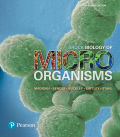
EBK BROCK BIOLOGY OF MICROORGANISMS
15th Edition
ISBN: 8220103633352
Author: Stahl
Publisher: PEARSON
expand_more
expand_more
format_list_bulleted
Concept explainers
Question
Chapter 28.2, Problem 1CR
Summary Introduction
Infectious diseases are disorders caused by microorganisms like bacteria,
Expert Solution & Answer
Want to see the full answer?
Check out a sample textbook solution
Students have asked these similar questions
Explain the concept of 'infection control' in a healthcare setting.
. Where are antibiotics utilized for other than in the treatment of infections
What is epidemiology? there are several ways pathogens can be transmitted including direct contact, indirect contact, via respiratory droplets, vehicle, and through a vector. Describe each mode IN DETAIL and give an example of a pathogen that can be transmitted each way.
Chapter 28 Solutions
EBK BROCK BIOLOGY OF MICROORGANISMS
Ch. 28.1 - The use of personal protective equipment (PPE) is...Ch. 28.1 - Identify and discuss the standard safety...Ch. 28.1 - Prob. 1CRCh. 28.2 - Prob. 1MQCh. 28.2 - How can the spread of HAIs be controlled?Ch. 28.2 - Prob. 1CRCh. 28.3 - What are the key points necessary for proper...Ch. 28.3 - Identify culture methods and conditions used for...Ch. 28.3 - QWhy is it important to process clinical specimens...Ch. 28.4 - Describe the disc diffusion test and the Etest for...
Ch. 28.4 - What is the value of antimicrobial drug...Ch. 28.4 - QDescribe the disc diffusion test for antibiotic...Ch. 28.5 - Explain the reasons for changes in antibody titer...Ch. 28.5 - Describe the method, time frame, and rationale for...Ch. 28.5 - What advantages do monoclonal antibodies have...Ch. 28.5 - QWhy does antibody titer rise after infection? Is...Ch. 28.6 - How is the bivalence of antibodies significant for...Ch. 28.6 - What are the advantages and disadvantages of...Ch. 28.6 - Why are agglutination tests so widely used in...Ch. 28.7 - Prob. 1MQCh. 28.7 - Compare the advantages and disadvantages of EIA,...Ch. 28.7 - Prob. 1CRCh. 28.8 - What advantage(s) does nucleic acid amplification...Ch. 28.8 - How do quantitative PCR (qPCR) and qualitative PCR...Ch. 28.8 - Distinguish between quantitative and qualitative...Ch. 28.9 - Compare and contrast live attenuated vaccines,...Ch. 28.9 - Identify the advantages of alternative...Ch. 28.9 - QList the immunizations recommended for children...Ch. 28.10 - Prob. 1MQCh. 28.10 - How does the activity of each antibiotic class...Ch. 28.10 - What are the sources of aminoglycosides,...Ch. 28.10 - Antibiotics are chemically diverse antimicrobial...Ch. 28.11 - What steps in the viral maturation process are...Ch. 28.11 - Why are there fewer clinically effective...Ch. 28.11 - Why is host toxicity a common problem with...Ch. 28.12 - Identify the basic mechanisms of antibiotic...Ch. 28.12 - What does vancomycin have in common with...Ch. 28.12 - Prob. 3MQCh. 28.12 - What practices contribute to the spread of...Ch. 28 - Define the procedures you would use to isolate and...Ch. 28 - Prob. 2AQCh. 28 - Describe three important reasons why semisynthetic...Ch. 28 - Imagine yourself as a clinical microbiologist with...
Knowledge Booster
Learn more about
Need a deep-dive on the concept behind this application? Look no further. Learn more about this topic, biology and related others by exploring similar questions and additional content below.Similar questions
- Where along the chain of infection can we, as medical care providers, easily break to reduce the transmission of contaminants and infectious agents? Justify your response.arrow_forwardDraw an editorial cartoon on the importance of the roles of the multi-agency teams in communicable disease prevention and control. Explain the meaning of the cartoon.arrow_forwardIt is well What is the intersection between environmental conditions and communicable diseases? Discuss which communicable diseases might be most impacted by environmental factors? What is the burden for people living in the most vulnerable world regions (based on environmental hazards, and lack of access to public health resources to address these environmental conditions)?arrow_forward
- Describe the chain of transmission of communicable diseases and explain how infectious agents are transmitted by direct and indirect modes (Answer in 800 words)arrow_forwardA.) The difference between direct and indirect contact infection? Example B.) Name methods for breaking down transmission routesarrow_forwardDiscuss important aspects of health-care-associated infections andtheir impact on patients in clinical settings.arrow_forward
- Describe the difference between the terms INFECTION and DISEASE. Starting with exposure to pathogens, describe IN DETAIL the steps involved in the infection process ( exposure, adherence, invasion and multiplication) as well as the disease process( Toxicity, invasiveness, tissue or system damage)arrow_forwardDo it please as soon as possiblearrow_forwardHow do pathogenic microbes successfully invade the body systems and cause infections or diseases to healthy individuals? Discuss all possibilitiesarrow_forward
arrow_back_ios
SEE MORE QUESTIONS
arrow_forward_ios
Recommended textbooks for you

